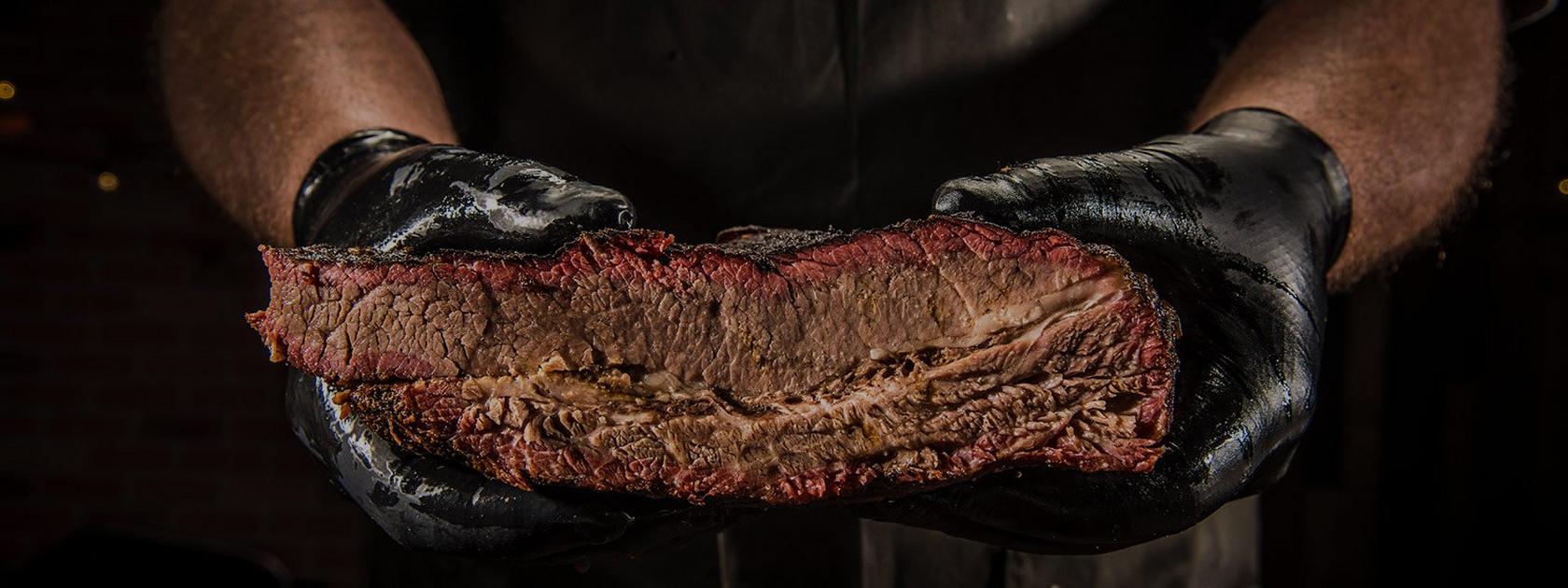
There are a lot of incredible ways to cook meat, but at the end of the day, nothing compares to a wood pellet grill. A pellet grill has the versatility to give you low temperatures for smoking, but also high temperatures for searing. And if you decide you'd rather braise or roast, you can do that too.
Just about everything tastes better smoked. But not all cuts are created equal. You'll want to factor in things like the time it takes to smoke the meat (including prep time), the cost of the meat, and how "forgiving" the meat is — in other words, how skilled you need to be to get a good result.
To help you make the most of your outdoor gathering and prove to everybody you’re a true grillmaster, we’ve rounded up the top recipes to form the ultimate guide on the best meat to smoke.
Smoking Meat Times & Temperatures
Time + temperature — that's how you smoke meat. Most experts recommend a smoking temperature between 165-275ºF.
The smoking time will depend on the cut of meat you are smoking. The size of the cut, the shape of the cut, outside temperatures, and even the individual animal the meat comes from can affect the cooking time. On a smoking day, don't make any firm plans, and have a meat thermometer handy. For most larger cuts, expect to smoke for 6 hours, minimum. For smaller cuts, there are different ways you can smoke. For example, if you own a Traeger you can reverse sear a steak — cook it for about 45-60 minutes, take the steak off the grill, then raise the temperature to high and sear on both sides until cooked to your desired temperature. More on this later.
Why such a low temperature? Because the longer the meat cooks, the more time it has to absorb that smoke flavor coming from the low and slow burning hardwood. Also, most of the popular smoking meats — ribs, briskets, pork shoulder — require a long cooking time so that the tough fibers in the meat get delectably tender.
Don't have time to smoke? One nice thing about owning a Traeger is how many options you have that still give you the wood-fired flavor. If you need to cook something faster, you can use your Traeger as a grill or an oven as well. See our grilling, roasting, baking, BBQing, and braising recipes to see alternate ways to cook some of these same meats.
Beginner Smoking
If you're just getting started with your smoking journey, these are a few foolproof items to try. Most of our Traeger experts recommend smoking temperatures between 165-275ºF. If the temperature is lower than 165ºF, meat may not get warm enough to cook safely. If the temperature is higher than 275ºF, you aren't going to get as much of the smoke flavor as you'd like.
Smoking Salmon
Recommended wood pellet flavor: Mesquite
This simple process will give you fantastic wood-fired results every time.
- Marinating (2-4 hours): Massage a marinade of brown sugar, pepper, salt, and vodka into the fish. Refrigerate for 2-4 hours.
- Smoke (75-90 minutes): Smoke the salmon skin-side down at 180ºF for 30 minutes. Then increase the temperature to 225ºF and smoke for an additional 45-60 minutes.
The salmon is cooked when the internal temperature reaches 140ºF.
See our Traeger Smoked Salmon recipe for more details.
Recommended wood pellet flavor: Mesquite
This simple process will give you fantastic wood-fired results every time.
- Marinating (2-4 hours): Massage a marinade of brown sugar, pepper, salt, and vodka into the fish. Refrigerate for 2-4 hours.
- Smoke (75-90 minutes): Smoke the salmon skin-side down at 180ºF for 30 minutes. Then increase the temperature to 225ºF and smoke for an additional 45-60 minutes.
The salmon is cooked when the internal temperature reaches 140ºF.
See our Traeger Smoked Salmon recipe for more details.
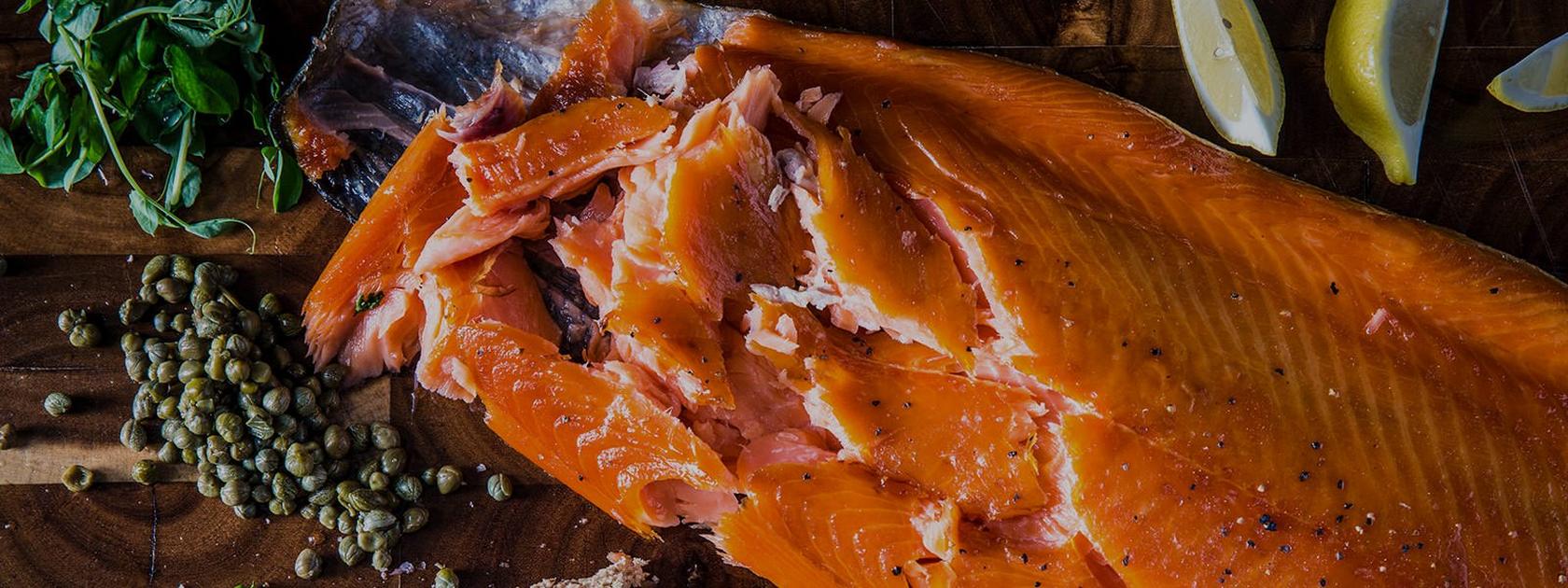
Smoking Chicken Drumsticks
Recommended wood pellet flavor: Mesquite
The classic drumstick can be a beginner's best friend. Drumsticks, like other bone-in cuts, can stay moist through long periods of cooking. Since you can cook them longer, that means you have more time for delicious smoke flavor.
For smoked chicken drumsticks, you'll typically season the meat with your favorite rub, then let it rest for 20 minutes to absorb the seasoning. You'll hang the drumsticks on a leg hanger (or place them directly on the grill grate flipping halfway through), for 1 hour at a grill temperature of 275°F. Then, slow-smoke them in a pan. Once they've reached the proper temperature, you can add sauce as well. The whole process takes about 2 hours.
See our BBQ Chicken Drumsticks recipe for all the details.
Smoking Steak
Recommended wood pellet flavor: Hickory
You've probably seared steak on the grill before — But have you experimented with smoking tri-tip on your Traeger?
To grill tri-tip you season it like you would any steak, but cook over a low temperature for 60-90 minutes. This gives you the deep smoke flavor. Once you've reached just below the steak doneness level you prefer, you crank up the heat and sear for 4 minutes on each side.
Our Smoked Tri-Tip recipe has everything you need to get started.
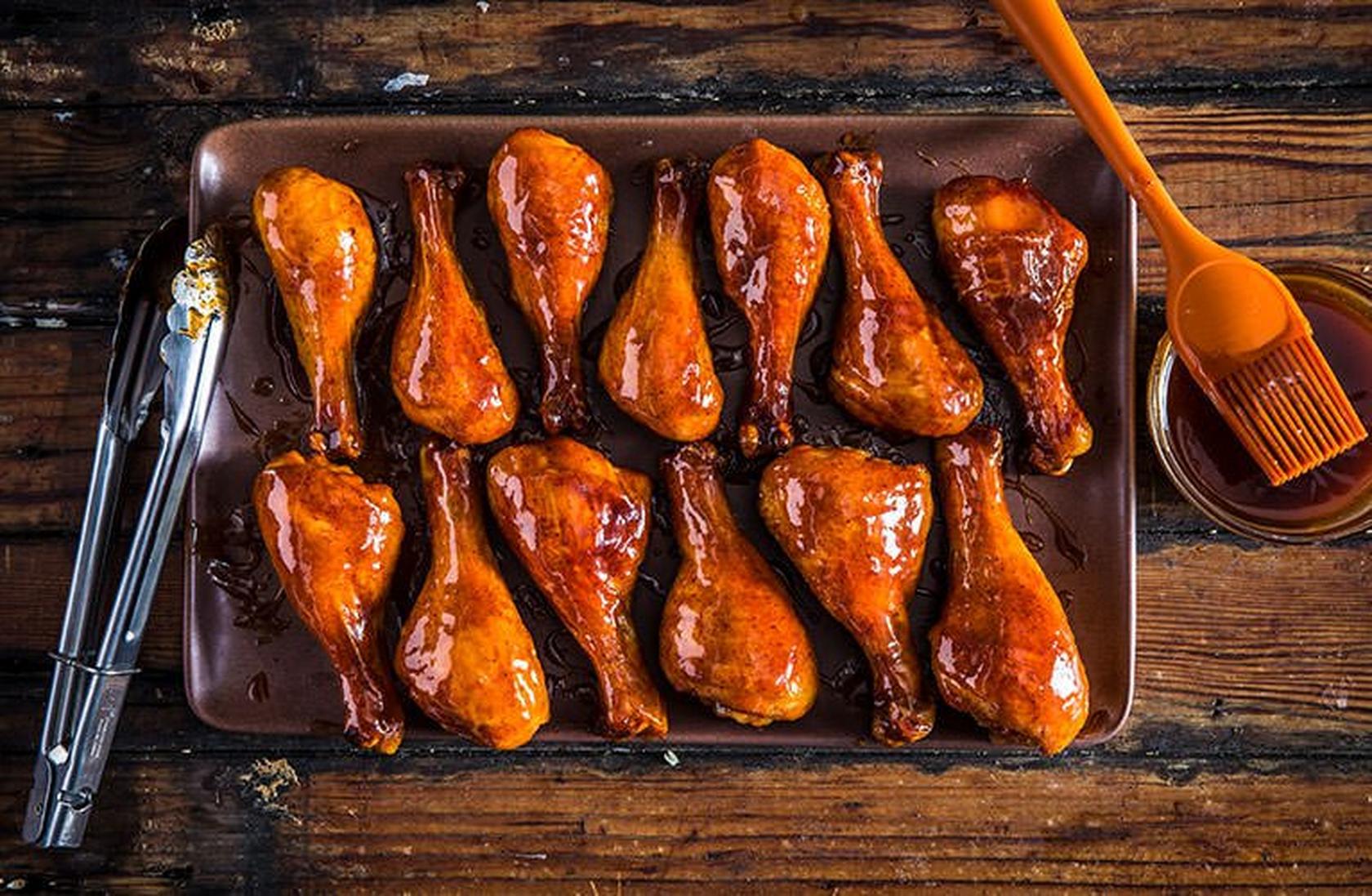
Smoking Tri Tip
Recommended wood pellet flavor: Hickory
You've probably seared steak on the grill before — But have you experimented with smoking tri-tip on your Traeger?
To grill tri-tip you season it like you would any steak, but cook over a low temperature for 60-90 minutes. This gives you the deep smoke flavor. Once you've reached just below the steak doneness level you prefer, you crank up the heat and sear for 4 minutes on each side.
Our Smoked Tri-Tip recipe has everything you need to get started.
Intermediate Smoking
Do you feel comfortable with your smoking skills, have at least half-a-day free, and are ready to try something slightly challenging? These are the cuts for you.
Smoking Pork Ribs
Recommended wood pellet flavor: Apple
When you think about restaurant BBQ, does a fall-of-the-bone, perfectly-sauced rack of ribs come to mind? Now's the time to make that vision a reality in your own backyard.
Ribs are a very forgiving smoking meat. They are nearly impossible to overcook, and nearly always stay moist close to the bone. Plus you can experiment with rubs and sauces to add your own unique spin.
A good rule of thumb for smoked pork ribs is the 3-2-1 rule: That's 3 hours of smoke, 2 hours of low and slow cooking, and 1 hour of saucing. It's an investment of time, that's for sure. But the nice thing about ribs is that as long as you do give them enough time, you'll make the best ribs you've ever had.
See How to Smoke Ribs on the Grill for all of the details — from choosing ribs to chopping them.
Smoking Whole Chicken
Recommended wood pellet flavor: Apple
Smoking a whole chicken is a good intermediate grilling technique. You can pretty much just set it up and let your grill do the work — but you do have to do some preparation to avoid ending up with dry, rubbery chicken.
Traeger experts recommend brining the chicken overnight, using an injection to infuse moisture and flavor, or dry brine.
Set the pellet grill to 225ºF, and preheat with the lid closed for 15 minutes. Remove chicken from the brine (if used) and pat dry.
Place the whole chicken on a rack and cook for 2.5 to 3 hours. Once you get an internal temp of 160ºF, remove the chicken to let rest for 10-15 minutes, then carve and serve.
See our Traeger Whole Smoked Chicken recipe for all the details.
Smoking Prime Rib
Recommended wood pellet flavor: Cherry
The actual cooking part of smoking a prime rib of beef is actually the easy part. The harder part is giving yourself the proper lead time — at least 24 hours and maybe more.
Yes, that's right, if you're planning a Sunday prime rib dinner, you'll have to start prepping by noon on Saturday at the latest. Maybe even earlier. Once you have your prime rib, you'll need to season and let it rest in the fridge for at least 24 hours to absorb the flavors.
Once you're ready to cook, your Traeger makes it very easy. Set your Traeger to 275ºF and smoke until the internal temperature of the prime rib reaches 125ºF. (A 15-minute rest will bring the internal temp up to our recommended target, 130ºF.)
See our Smoked Prime Rib recipe for more details or our Prime Rib guide has all the info you need.
We strongly recommend only using Traeger pellets for smoking meat. Many other wood pellets have added chemicals. Ours are all-natural and Traeger’s product engineers have spent a lot of years studying smoke science to ensure our pellets have the best burn-to-smoke ratio that provides the best quality smoke for cooking.
Traeger also provides a wide selection of wood pellets — you need options because different woods pair better with different meats.
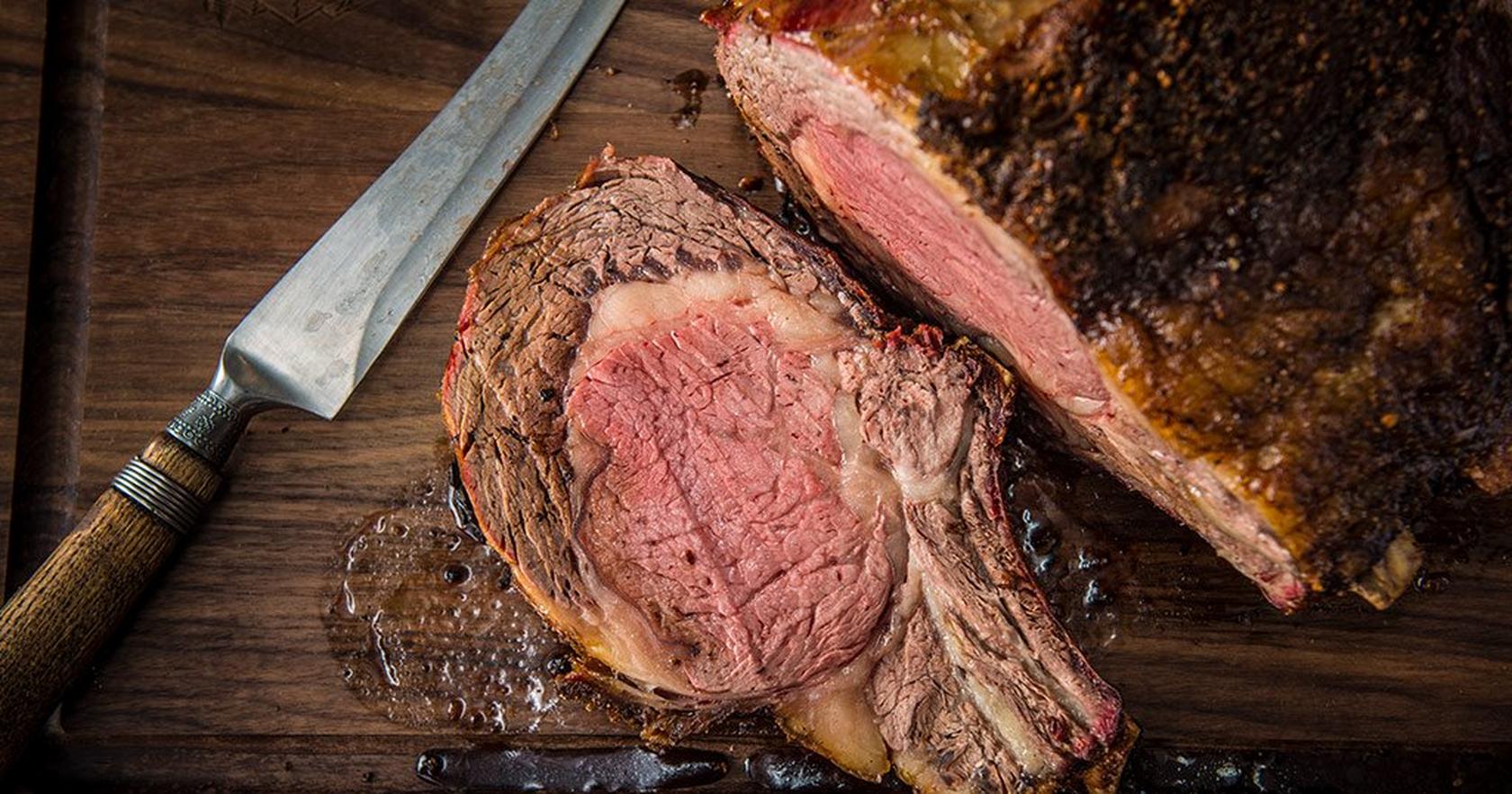
Advanced Smoking
If you're ready to become a true Master of Smoke, these are the cuts that earn you the diploma.
Smoking Brisket
Recommended wood pellet flavor: Brisket Blend
Beef brisket is the favored cut of Texas barbecue, the epicenter of the modern-day barbecue movement. Smoking a brisket at the level of the world's top smoke masters requires technique, skill, special equipment, and patience.
Brisket is very flavorful on its own, you don't need any elaborate seasoning or saucing. The trick is getting the smoke flavor to penetrate the rich meat without overcooking.
The good news is that your Traeger makes it easy to add the natural smoke flavor that otherwise requires stoking a fire for most of a day.
At 225°F grill temperature and raising the grill temperature to 275°F when brisket internal temp hits 160°F. For complete detailed instructions about prepping, smoking, and resting a brisket, see How to Make the Best Smoked Beef Brisket.
Beef has a heavy flavor that can stand up to the strongest woods. Hardwoods like mesquite, hickory, and oak are on the table when you're looking to add powerful flavor to a cut of beef.

Smoking Beef Ribs
Recommended wood pellet flavor: Cherry
Think of the beef rib as a canvas for your flavor experiments. As an advanced griller, you get to make the rules. Beef back ribs are larger, with less meat on the bone than pork ribs — more of the meat is in the middle.
Beef short ribs are a cut you're more likely to see in your local supermarket. They are a slightly different look. The meat is actually on top of the rib.
With beef short ribs, marinade and/or seasoning is the key. Our Mustard Beef Short Ribs recipe is a good place to start.
Recommended wood pellet flavor: Cherry
Think of the beef rib as a canvas for your flavor experiments. As an advanced griller, you get to make the rules. Beef back ribs are larger, with less meat on the bone than pork ribs — more of the meat is in the middle.
Beef short ribs are a cut you're more likely to see in your local supermarket. They are a slightly different look. The meat is actually on top of the rib.
With beef short ribs, marinade and/or seasoning is the key. Our Mustard Beef Short Ribs recipe is a good place to start.

Smoking Whole Turkey
Recommended wood pellet flavor: Turkey Blend
There's no better time to show off your advanced smoking skill than Thanksgiving. Your whole family will get to experience the incredible flavors you can create with your Traeger.
Of course, you'll need to put in a little effort. To keep the turkey meat moist, we recommend starting by brining your turkey overnight, as well as adding a layer of butter to the inside of the turkey breast skin. To ensure full smoke flavor, you'll be starting the bird at a low temperature, then finishing it at a higher one. Get all of the information from our Ultimate Smoked Turkey recipe.

Smoke Visibility
Pellet grills produce a lot of smoke when you're preheating it and when pellets start hitting the firepot. Although you can see it and smell it, that initial type of smoke is not the type of smoke you want all throughout your cook. The smoke you really want is thin, blue smoke — it's actually hard to see. Even though you won’t see it often, it's there, flavoring your meat and delivering that appetizing smoke ring.
Best Wood Pellets To Smoke With
We strongly recommend only using Traeger pellets for smoking meat. Many other wood pellets have added chemicals. Ours are all-natural and Traeger’s product engineers have spent a lot of years studying smoke science to ensure our pellets have the best burn-to-smoke ratio that provides the best quality smoke for cooking.
Traeger also provides a wide selection of wood pellets — you need options because different woods pair better with different meats.
Wood Pellets for Chicken
Chicken has a light flavor profile. That's why we typically prepare it with a rub or marinade before grilling — to add additional flavor. The light flavor of chicken is also why we don't want to overpower it with strong-flavored woods.
Sweet fruit woods are the best pairing for chicken. Consider apple or cherry. If you are marinating your chicken with a bold rub, you might consider a stronger wood like mesquite.
Wood Pellets for Pork
Like chicken, pork has a lighter flavor that pairs best with fruit woods. If you are seasoning the pork with light herbs, a subtle wood like apple might be a good choice.
If you are going for a richer flavor, for example, a mustard glaze, consider a richer wood, like maple or hickory.
Wood Pellets for Beef
Beef has a heavy flavor that can stand up to the strongest woods. Hardwoods like mesquite, hickory, and oak are on the table when you're looking to add powerful flavor to a cut of beef.
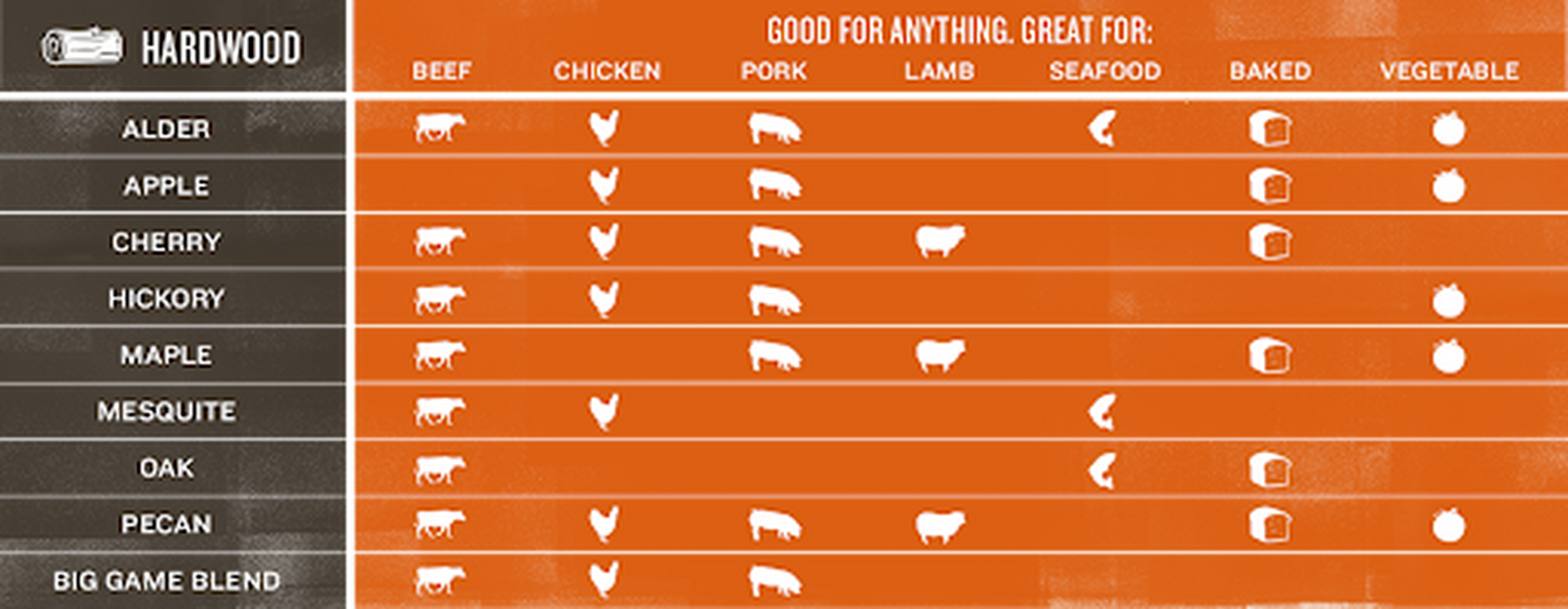
Beginner Tips For Smoking Meat
If you're new to smoking meat, here are a few additional things to keep in mind.
- If you're smoking for a long period of time, choose cuts with a higher fat content. Lean cuts are more likely to dry out.
- You can smoke lean cuts too, they just may not get as much smoke flavor, because they'll cook much faster. For example, smoked pork loin takes 2.5 to 3 hours.
- It's better to use a little less seasoning than you think you need to overseason your meat. You can always add extra seasoning at the end, but you can't take it away.
- Season meats an hour in advance or just before cooking. If you salt meats and wait 15 minutes to start cooking, the salt will draw a film of moisture that will need to evaporate before cooking begins, making the cooking process take longer.
- Always let meats rest before cutting to allow juices to redistribute. The larger the cut of meat, the longer it needs to rest.
- Pork shoulder has an amazing fat-to-lean ratio that will give you consistently moist and melt-in-your-mouth results without needing much rub or sauce. Shoulder also works hard for you in terms of serving large groups.
- Pork loin is a cut of meat that's a blank canvas for flavor and doesn't take very long to smoke.
321 Ribs
by Danielle "Diva Q" Bennett
907 Reviews
Prep Time
15 Min
Cook Time
6 Hr
Serves
6
Pellets
Hickory
Our famously easy 321 ribs will make your rib game the envy of the neighborhood. This super simple recipe takes all the confusion out of making baby back ribs without sacrificing any of the flavor. You'll begin this method by smoking your ribs for 3 hours, then cooking inside foil for 2 hours. Finish by removing your ribs from the foil, brushing on BBQ sauce, and then cook for another hour.
Ingredients
main
| 2 Rack | baby back pork ribs |
| 1/3 Cup | yellow mustard |
| 1/2 Cup | apple juice, divided |
| 1 Tablespoon | Worcestershire sauce |
| To Taste | Traeger Pork & Poultry Rub |
| 1/2 Cup | dark brown sugar |
| 1/3 Cup | honey, warmed |
| 1 Cup | Traeger 'Que BBQ Sauce |
1
If your butcher has not already done so, remove the thin silverskin membrane from the bone-side of the ribs by working the tip of a butter knife or a screwdriver underneath the membrane over a middle bone. Use paper towels to get a firm grip, then tear the membrane off.
2
In a small bowl, combine the mustard, 1/4 cup of apple juice (reserve the rest) and the Worcestershire sauce. Spread the mixture thinly on both sides of the ribs and season with Traeger Pork & Poultry Rub.
3
When ready to cook, set Traeger temperature to 180℉ and preheat, lid closed for 15 minutes. Smoke the ribs, meat-side up for 3 hours, or until the internal temperature reaches 160℉.
4
After the 321 ribs have smoked for 3 hours, transfer them to a rimmed baking sheet and increase the grill temperature to 225℉.
5
Tear off four long sheets of heavy-duty aluminum foil. Top with a rack of ribs and pull up the sides to keep the liquid enclosed. Sprinkle half the brown sugar on the rack, then top with half the honey and half the remaining apple juice. Use a bit more apple juice if you want more tender ribs. Lay another piece of foil on top and tightly crimp the edges so there is no leakage. Repeat with the remaining rack of Traeger 321 ribs.
6
Return the foiled ribs to the grill and cook for an additional 2 hours, or until internal temperature reaches 205℉.
7
Carefully remove the foil from the ribs and brush the ribs on both sides with Traeger 'Que Sauce. Discard the foil. Arrange the ribs directly on the grill grate and continue to grill until the sauce tightens, 30 to 60 minutes more.
8
Let the ribs rest for a few minutes before serving. Enjoy!